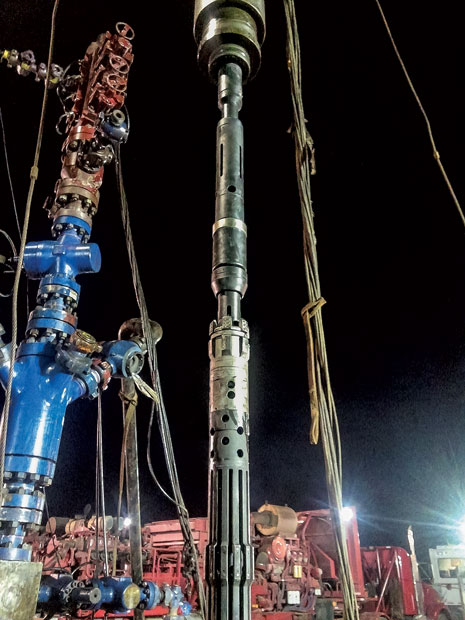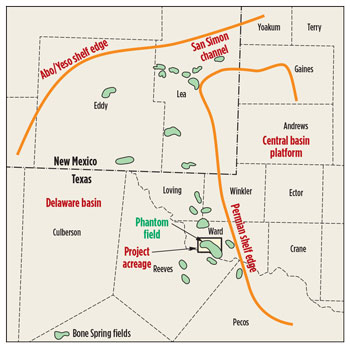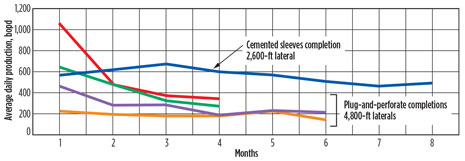 |
| The 41/2-in. Multistage Unlimited frac-isolation assembly suspended from the CT injector head, before running into the well to execute the completion. |
|
The liquids-rich Bone Spring sandstone in the Permian basin of West Texas is a well-developed part of the Delaware basin. It exhibits moderate porosity and low permeability, and is not naturally fractured, so stimulation is required for economic production. The Bone Spring has been widely developed for many years by use of vertical wellbores and fracture stimulation. More recently, horizontal drilling and multi-stage completion technology have significantly improved well economics, and boosted interest in the formation.
Although horizontal development of the Bone Spring has typically produced commercial results, operators continue to search for a more economical, efficient way to develop these sandstones, in an effort to improve decline curves, ultimate recovery and return on investment.
The wells described in this article are in Phantom field of Ward County, Texas, which is one of the 20 or so Bone Spring fields in southeastern New Mexico and West Texas, Fig.1. In Phantom field, wells are drilled horizontally into the sands of the Bone Spring, where the net pay averages approximately 12 ft to 20 ft.
 |
| Fig. 1. Phantom field is in Ward County, Texas, near the Permian Shelf edge. |
|
Wells are drilled, completed and produced with the goal of maximizing ultimate recovery from the reservoir. The strategy involves controlled drilling, using rotary steerable systems and logging-while-drilling to stay within the formation. All fractures are propped with high-strength proppant to maximize production life, and, in keeping with the commitment to long-range recoverability, wells are produced with controlled flowback, through chokes, for improved reserves estimates.
The drilling plan calls for parallel wellbores approximately 4,800 ft long and about 1,100 ft apart, yielding four wellbores per square-mile section. Typical TVD is 11,200 ft, and typical TMD is 16,000 ft.
PLUG-AND-PERF COMPLETIONS EVALUATED
Arrington Oil & Gas began horizontal development of the Bone Spring sandstone, using conventional plug-and-perf, by far the most common completion method used in multi-stage completions. Frac modeling predicted simple planar fracture geometry for the relatively ductile sandstone formation, and optimum fracture length was calculated to be approximately 320 ft.
Logs indicated consistent hydrocarbon potential across the 4,800-ft laterals, so Arrington used geometric stage spacing comprising 12 stages, each with four, 2-ft-long perforation clusters at 6 shots/ft. Each stage received 160,000 lb of proppant. Theoretically, each perforation cluster would receive 40,000 lb of proppant, but, with multi-cluster stages, proppant distribution cannot be controlled. A microseismic survey conducted on one of the wells revealed that cluster stimulation was highly variable across the lateral section, and identified fractures extending far beyond the frac model calculation, with one fracture ultimately communicating with an existing well more than 3,000 ft away. Arrington concluded that other clusters in that stage received little or no stimulation. This conclusion was supported by a number of published studies, which found that proppant distribution varies greatly within multi-cluster stages, with almost 30% of perforation clusters not contributing to production.¹²³
After evaluating production results, formation properties, microseismic data and the industry studies, Arrington estimated that as much as 40% of the reservoir was not being stimulated. The company began a search for completion methods that would increase the stimulated reservoir volume (SRV), while preventing communication between stages and between wells.
A MORE EFFICIENT FRACTURE NETWORK
One of the alternative completion methods, the Multistage Unlimited system from NCS Energy Services, combines cemented casing sleeves with a CT-deployed frac-isolation assembly, to deliver precise frac initiation and consistent propped volumes, independent of variable breakdown pressures across the lateral. Such a frac network would be expected to deliver better reservoir connectivity, compared with the typical plug-and-perf network.
HOW THE MULTI-STAGE UNLIMITED SYSTEM WORKS
The casing sleeves match the specifications of the host casing and, unlike conventional ball-drop sleeves, are full-drift at all times, so they permit normal cementing. In addition, all the sleeves for a given well are identical, so they can be made up into the casing string in any order, just like casing joints. The frac-isolation tool assembly (Fig. 2) comprises a sleeve locator, a resettable isolation bridge plug and a sand-jet perforating sub that can be used to add stages in blank casing, if desired.
 |
| Fig. 2. Multistage Unlimited frac-isolation assembly. |
|
During stimulation, the frac-isolation assembly is run on CT to locate the lowest casing sleeve. The isolation bridge plug is then set inside the casing sleeve, where it grips and seals inside the inner sleeve barrel, Fig. 3. An increase in wellbore pressure from the surface forces the bridge plug assembly and sleeve barrel down, opening six large frac ports at the top of the outer sleeve, Fig. 4. Fluid and proppant are then pumped down the annulus, between the CT and casing, and into the formation, while the CT serves as a dead string to provide real-time frac-zone pressure. When the frac is away, a pull on the CT re-sets the bridge plug, and the assembly is moved up to locate the next sleeve. This sequence is repeated until all stages have been stimulated. Then, the frac-isolation assembly is pulled from the well, leaving a fully open, production-ready wellbore.
 |
| Fig. 3. The frac-isolation bridge plug, deployed on CT inside the cemented casing sleeve, gripping the inner barrel and isolating the zone from the well below. |
|
 |
| Fig. 4. Casing pressure forces the bridge plug assembly and inner sleeve barrel downward, opening the frac ports. Fluid and proppant are pumped down the annulus between the CT and the casing. |
|
COMPLETION WITH CEMENTED CASING SLEEVES
The Multistage Unlmited CT completion technology was employed on a subsequent well on the same lease acreage as the plug-and-perf wells described above. This well was drilled in the same manner as the plug-and-perf wells, and the sleeves were run and cemented with the liner. For ease of spacing, the casing sleeves were placed 96 ft apart (the sleeves come with a 6-ft handling sub). The planned lateral section had 44 sleeves—roughly comparable to the plug-and-perf completions—which had 48 perforation clusters at approximately 80- to 100-ft spacing.
Because of wellbore difficulties, the liner could not be run all the way to the toe, and the resulting lateral was only 2,600 ft long with 29 stages (sleeves). After the liner was cemented, the stages were stimulated using the CT-deployed assembly.
During the fracturing operation, approximately 40,000 lb of proppant were placed in each stage, thereby controlling fracture volume and length. Using the CT dead string to observe actual fracture-zone pressure, Arrington was able to optimize rates, fluid viscosity and proppant concentration for each stage. The pressure plot also aided in preventing premature screen-outs, because fluid could be injected quickly at the frac zone through the CT to decrease proppant loading.
The result was 29 fully stimulated stages, versus 48 clusters of variable spacing and quality on the plug-and-perf wells.
PRODUCTION COMPARISONS
Arrington compared production from the cemented-sleeves well to the three, previous plug-and-perf wells, Fig. 5. Production from the cemented-sleeves completion was significantly higher through eight months than that from any of the plug-and-perf completions, even though its interval was much shorter. The data points represent daily production averaged over one month.
 |
| Fig. 5. Comparison of average daily production from the PnP wells and the well completed using cemented casing sleeves. All the wells are on the same lease acreage and were drilled into the same sandstone, in the same manner. |
|
The cemented-sleeve completion was also compared with four wells on adjacent lease acreage, all of which were completed with plug-and-perf, Fig. 6. These four wells were not drilled in the same manner, but all have approximately 4,800-ft laterals with 12 stages of four perforation clusters, each. Here, again, production from the shorter cemented-casing-sleeves completion was
significantly higher.
 |
| Fig. 6. Comparison of average daily production from PnP wells on adjacent lease acreage and the well completed using cemented casing sleeves. |
|
OPERATIONAL ADVANTAGES
In addition to production benefits, Arrington found that the CT-deployed frac-isolation system provided several operational advantages over plug-and-perf methods:
- The ability to observe actual fracture-zone pressure through the CT dead string made it possible to control the fracture process by adjusting fluid viscosity, proppant concentration and pump rates in real time.
- Having CT in the hole allowed proppant from screen-outs to be circulated out quickly.
- No drill-outs are required, so production can start immediately.
- Single-point injection requires lower flowrates for stimulation, so fewer fracturing units are needed.
- By reducing the number of personnel and amount of equipment, and by eliminating explosives, Multistage Unlimited technology reduced personnel risk and simplified logistics.
CONCLUSION
For Arrington, single-point injection using cemented casing sleeves provided control over stage spacing and fracture propped volume, enabling a more efficient fracture network that resulted in better reservoir connectivity (stimulated reservoir volume) and significantly improved production. Subsequent wells are being completed using the cemented casing sleeves and CT-deployed frac-isolation system. 
ACKNOWLEDGEMENT
This article is adapted from SPE paper 168633-MS, presented by the authors at the SPE Hydraulic Fracturing Technology Conference in The Woodlands, Texas, Feb. 4–6, 2014. The authors wish to thank Arrington Oil & Gas Operating LLC and NCS Energy Services LLC for assistance in preparing this paper.
REFERENCES
- Crespo, F., et al., “Proppant distribution in multi-stage hydraulic fractured wells: A large-scale inside-casing investigation,” APE paper 163856, presented at the SPE Hydraulic Fracturing Technology Conference, The Woodlands, Texas, Feb. 4–6, 2014.
- Castro, L., et al., “A comparison of proppant placement, well performance, and estimated ultimate recovery between horizontal wells completed with multi-cluster plug & perf and hydraulically activated frac ports in a tight gas reservoir,” SPE paper 163820, presented at the SPE Hydraulic Fracturing Technology Conference, The Woodlands, Texas, Feb. 4–6, 2014.
- Miller, C., et al., “Evaluation of production log data from horizontal wells drilled in organic shales,” SPE paper 144326, presented at the SPE North American Unconventional Gas Conference and Exhibition, The Woodlands, Texas, June 14–16, 2011.
|









